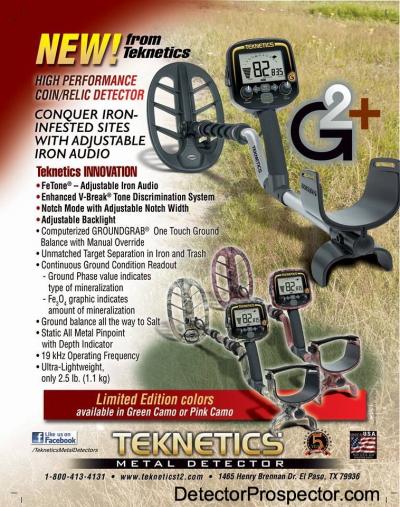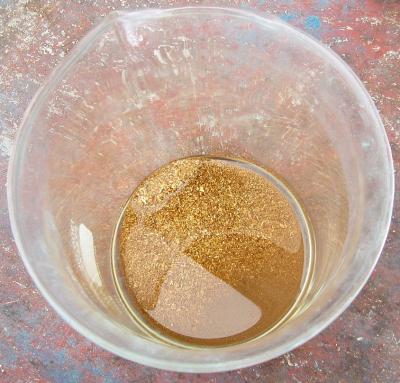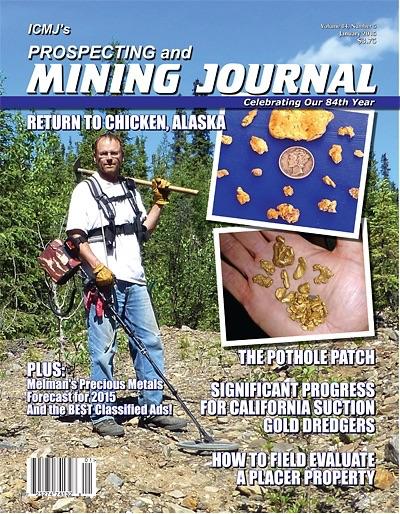-
Posts
883 -
Joined
-
Last visited
Content Type
Forums
Detector Prospector Home
Detector Database
Downloads
Everything posted by Reno Chris
-

How To Weigh Gold And Such?
Reno Chris replied to tvanwho's topic in Rocks, Minerals, Gems & Geology
Harder to find digital scales in grains and dwt - not as popular, so they are rare. Far more common is weight in grams. The whole rest of the world uses metric weights. You can use a calculator and translate gram weights to grains. 1.55 grams is a pennyweight, and a dwt has 24 grains. The more accurate your scale, the more it will cost. A scale that is accurate to 1/100 of a gram is fairly cheap - try Amazon. Less than $20. One which is accurate to 1/1000th of a gram will be more expensive than $40. I paid about $100 for mine. -
Like Steve noted, I am very interested in hearing more about the Gold Racer when that info is available (and I am sure many here are interested in that also).
-
Long ago I read a nugget weighs more than a grain. It is however as Steve says, a matter of opinion.
-
For Indiana, that's a danged impressive nugget! I have a friend who prospects there and I've seen his gold - its dust and tiny flakes. You'll probably start an Indiana gold rush. Got a scale capable of weighing it?
-
Yes, Ive done it a couple times. If you turn your phone off, no worries, if you move your phone to the other front pocket, no worries, or if you leave your phone in your car, no problem. When the phone is only inches from the SDC body as you swing, it generates a signal, but it really doesnt sound exactly like a good target, but enough to make you stop to listen.
-
Some of the other wins we have had recently were little cracks in California's defense, but this is a very big crack with a decent sized gap between the cracks. I saw recently on the local news that a California law that banned a french delicacy known as pate fois gras was overturned as it contradicted federal law - it was banned at the behest of some animal rights activist groups. Some poor restaurant owner fought them for years, spent many thousands, but won. The Sacramento money whore politicians just figure they can do whatever and if don't like it sue them. If you are a special interest, they will do whatever you want for money and votes. Steve - you may get to dredge in the warm, clear water of California yet!
-

Detector Dilemna GPX or SDC?
Reno Chris replied to Junkman's topic in Metal Detector Advice & Comparisons
Yep, I have heard there is some very hot ground in VA. However mine dumps tend to be lots of quartz and not nearly as hot as some general ground where relics are found, and no state is uniformly hot or mild. Perhaps the best advice would be to contact some local prospectors directly and ask their thoughts on metal detecting. The state has two GPAA chapters: GPAA of Virginia (Central Virginia Gold Prospectors), Jack Wyatt (434) 728-2108 GPAA of Virginia (Hillsville), Bill Humble (276) 251-2198 (from the ICMJ website) -

Detector Dilemna GPX or SDC?
Reno Chris replied to Junkman's topic in Metal Detector Advice & Comparisons
I agree Steve and Goldbrick that a VLF is way better for old hard rock mine tailings - most are just way too trashy for a detector with no discrimination (the SDC) or one with poor discrimination on specimen gold such as you are more likely to find in a tailings pile (the GPX). Given the more limited detecting opportunities in the east, I would recommend a good VLF. If you lived in the west and had access to good places out here, I would recommend the SDC for new, inexperienced prospectors over the 5000. -
I think we will see a gold oriented PI from Fisher eventually, but who knows if it will be 2015 or 2016 or ??????? Given potential sales in international markets, its just to big a market segment to ignore, I don't think anyone who wants a PI now should hold off to wait and I don't think its just right around the corner (like it is going to be available to purchase in the next few months kind of thing). If it were going to be available just in the coming few months, I think we would have heard a lot more about it,
-
And yet there are big gossans in Nevada with only tiny traces gold - they have more silver, lead and base metals.
-
A blow out is a term for a pod or blob of other material in rock - as opposed to a long and narrow vein. Quartz or iron minerals are common things to find. Sometimes pegmatites can form this way too. Limonite is an iron oxide. It can yellow to orange and even brick red. In quartz veins, Limonite can form from the decomposition of pyrite by weathering. If there was gold in the original pyrite there will be gold in the resulting limonite.
-

Do You Leach?
Reno Chris replied to Mike Hillis's topic in Gold Panning, Sluicing, Dredging, Drywashing, Etc
Long story on the electronics. They were several pounds of gold plated contact pins. A guy I know of but never met somehow acquired them - I have no idea where they came from. Some years later he passed away, and a friend of mine was given them for helping the widow sell his extensive collection of mining equipment. Some years later my friend passed and I helped his widow sell his equipment and was given a few oddball things, including these pins. The gold plate has now been melted down with some gold jewelry I detected into a button weighing about 1.75 ounces. -

Do You Leach?
Reno Chris replied to Mike Hillis's topic in Gold Panning, Sluicing, Dredging, Drywashing, Etc
The work of electronics is in chasing down and acquiring the electronics, tearing them apart, and properly disposing of the non-recyclable waste materials. -

Do You Leach?
Reno Chris replied to Mike Hillis's topic in Gold Panning, Sluicing, Dredging, Drywashing, Etc
In 2014, I removed the gold plating from a bunch of electronics. It is very possible and even common to digest some of the underlying metal and loosen the gold plate so that it can be separated. The attached photo shows about 1/2 ounce of gold plate I separated from those electronics in the spring of 2014. -

My First Year With The Garrett Atx
Reno Chris replied to Steve Herschbach's topic in Garrett Metal Detectors
Hey, you had a pretty good year with that detector! -
The association of gold and iron is an important one. Nearly all gold deposits form from hot water solutions underground which contain gold and circulate to move gold from one area and concentrate it in another such as in a vein. There are several different chemical mechanisms which cause the gold to come out of solution and precipitate, and one of these is contact with iron bearing minerals. The reaction of the watery gold solutions with iron bearing minerals causes the gold to come out of the solution and form metallic free gold, including nuggets. Sometimes the gold comes out of solution for reasons which have nothing to do with iron minerals, but sometimes it is the iron. However, this is not a universal situation that wherever iron exists there will automatically be some gold. In some places where gold bearing deposits are eroding on the surface of the ground, the rust colors caused by the weathering of iron minerals can be a good indicator that gold may be present. In other places, - the vast majority - rust colored mineralization means absolutely nothing. Iron is the fourth most common element in the Earth's crust and appears all over the place. Gold is much, much rarer and appears only in a certain few places. Lots of new prospectors would like to find some universal rule for finding gold, like if the soil is red, you will be able to find gold there; or if there is quartz vein material on the ground, there will be gold most of the time; or where if you find a contact of two different types of rock there will be a gold deposit at that place; or if you see bedrock along a stream, there will be gold on the bedrock. These are rules which work fairly well in certain places, but only in those places and they're far from universal. So you just have to learn which rules work in which mining districts and with which kinds of deposits. It's more work but that's just how gold is. What works well in your location is what works well in your location and not necessarily something that will work in other places.
-

Do You Leach?
Reno Chris replied to Mike Hillis's topic in Gold Panning, Sluicing, Dredging, Drywashing, Etc
Sorry have been slow in making reply on this and a couple other threads. The been out of town for almost two weeks and am catching up on things that didn't get done while I was gone. Generally speaking, individual prospectors have no reason to be doing any leaching. While it's true something like 80% of the world's newly mined gold comes from cyanide leaching operations, the big commercial operations are hugely different than ours. Gold specimens with visible gold such as we might find with a metal detector take forever to leach because the process to dissolve the gold is slow. This is why mining companies that work with cyanide process ores with tiny or even microscopic gold particles. If there is any bigger gold in there ore, they use gravity equipment circuits to capture that larger stuff. Bigger, easily visible particles of gold such as even the smallest pieces which could be found with a high-frequency VLF or recovered by a gold pan or dredge take a year or more to dissolve in most leach solutions. This is a topic on which one could write many books, and there are whole books on the subject. I did a whole article on alternative leeching solutions for the ICMJ prospecting and mining journal about a year ago. While some are less toxic than cyanide, most of these alternatives are toxic in their own right - it's just a matter of how much or how little material it would take to kill you. I get questions about leaching black sands, and I tell people over and over that the only gold in 99.9% of all black sands is tiny particles of free gold which can be recovered by other methods like the blue bowl, etc. The truth is that in nearly every case, there is no magic gold locked inside the particles of black sand which can be recovered by leaching. individual prospectors are thinking about processing small amounts of or by leaching, but even rich ores would require you to leach tons of material to get a decent return. This is why very few individual prospectors get into leaching in any form and why it remains the domain of large commercial operations. Chemistry is a difficult subject and most people don't want to get into the technical aspects of it, but if you go and mess around with chemicals you need to understand what you're doing - and not just in a cursory way that the seller gave you a 5 minute instruction on use as you're going out the door with his product. Even standard cleaning products that we have around our homes, if you mix the wrong ones it can easily kill you. Liquid bleach and ammonia, two very common cleaning chemicals mixed together produce deadly chloramine gas. Many toilet cleaners and pipe cleaners like Drano are highly acidic, and if you mix them with bleach will produce deadly chlorine gas. There are a fair number of people who die each year in household accidents in the USA from mixing standard cleaning products which should never be mixed. Potassium iodide, listed above as one of the "leach products" in this poll does not dissolve gold or silver. It is used as a stabilizer with elemental, free iodine. It is the free iodine that can dissolve gold. Iodine will however, not dissolve silver as silver iodide is insoluble. Cyanide is of course what virtually all the mining companies use. Believe me, if they could come up with a non-toxic easy to use alternative, it would have been in use decades ago. The big mining companies Have teams of chemists and do spend a significant amount of money on research and development. Cyanide is used because it is low cost, captures both gold and silver, and is safe if handled properly by folks who know what they are doing. As Steve said, I set up and ran a small heap leaching operation in Nevada in the early 1980s. We were careful and never had any problems with the cyanide that we used, but we were prepared with chemicals to neutralize the cyanide and treatments in case employees were accidentally exposed. Like most mining companies using cyanide, those safety measures were never necessary but we had them on hand just in case. -
Here is a little video I helped make on using a mortar and pestle to recover gold from specimen rock. Some specimens are really beautiful (like the one Steve showed here recently) but some are more pedestrian, and not really valuable as mineral specimens. These need to be crushed to recover the gold and this video shows how to do it cheaply and easily.
-

Drones For Aerial Reconnaissance
Reno Chris replied to Steve Herschbach's topic in Detector Prospector Forum
I've never used a drone - Mostly I use Google Earth for those types of situations where I want to see things a bit before I get there. With commercially available low cost drones, you pretty much need to be on site - drones you cant really tell you what someplace many, many miles away is like - they don't transmit that far. Many have limits less than a mile. There are also legal restrictions on flying over some types of federal land. I am sure some day future prospectors will use drones, but I think its still a bit off in the future yet. -

Nokta Scores Spectacular Gold Specimen
Reno Chris replied to Steve Herschbach's topic in Nokta / Makro Metal Detectors
Very spectacular and quite a find in any location - California or Alaska or Nevada. The lower 48 isn't so bad, is it? -
I've certainly not had the same level of interference on my T2 that you had seen on your old F75. I never had any real problem with my T2 working parks and schools around town. Perhaps we could do a little testing after Jan 1st and a couple of local parks / schools while the kids are still out on vacation. Assuming the weather cooperates.
-
There are a few areas of very salty ground out in the Sawtooth area of Nevada. Not like the salt flats of WA, but way too salty to work except in a salt mode, especially if there is any dampness in the ground.




